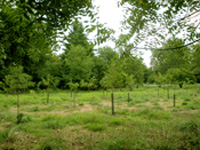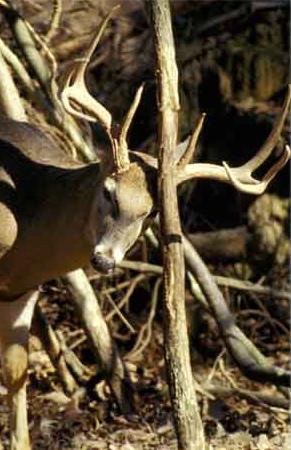Easement Maintenance Tips
How do I turn my easement into a forest?
 If the easement on your property is not forested, there are several ways to encourage it to become forest. Most areas in this region will naturally regenerate into successional forests if not maintained as lawns. Frequent mowing prevents trees, shrubs and other forest plants from being able to establish, but once the activity stops, tall grasses, shrubs and, eventually, trees begin to take root.
If the easement on your property is not forested, there are several ways to encourage it to become forest. Most areas in this region will naturally regenerate into successional forests if not maintained as lawns. Frequent mowing prevents trees, shrubs and other forest plants from being able to establish, but once the activity stops, tall grasses, shrubs and, eventually, trees begin to take root.
To make your easement become forest more quickly, the best thing to do is to plant trees. The number of trees you plant will depend on the size of the area and the size of the trees. A good rule of thumb is 50, 6-foot trees for every 10,000 square feet. Mowing only once or twice a year around newly planted trees can help limit the growth of large grasses, which can compete for nutrients and water. It also will keep noxious weeds from growing. This type of maintenance may be necessary until your trees grow large enough to form a closed canopy, at which point sunlight will be blocked from much of the ground, limiting the ability of non-forest plants to grow. This will ensure that the trees you planted have the best chance to survive.
An alternative to mowing around your planted trees is to cover the ground with a layer of mulch. This can be done in the first few years following planting, until the trees are large enough to form a closed canopy and natural understory starts to develop. The mulch should never be too deep – commonly known as “volcano mulching” – as this will cause the soil to retain too much moisture and may lead to poor health for your trees. Instead, put just enough mulch – about 3 to 4 inches deep – to prevent grasses from growing around your tree planting area. This will help simulate a forest floor, which is free of grasses.
What species should I use?
To transition your unforested easement into a healthy forest, consider the best species to plant in your area. Different soil, moisture and light conditions will require different native species of trees. Your local landscaper or nursery will know the best plant for each location, or consider our list of some native species at the Montgomery County Leaves for Neighborhoods program. You may also consider consulting the Forest Conservation Plan for your development. This plan will highlight the conditions present when your property was developed and may contain some insight into appropriate species.
Consider a variety of species with different growth patterns. Some trees are fast growing, but they aren’t as long-lived. These species can help close the forest canopy quickly, enabling slower growing – and longer lived – species a better chance of survival. You also may want to consider planting understory trees and shrubs. While these don't grow to the full height of the larger canopy trees, they provide an important role in maintaining the forest floor and keeping the area free of invasive species.
Timing
The best time of year to plant a tree is in early spring or late fall, when a tree is most able to tolerate the stresses of being relocated. Avoid planting during the summer months, when increased heat and light create an increased need for moisture for trees. Your newly planted tree will not have a fully developed root system, meaning it will not be able to get all the moisture it requires to survive in hot months. By contrast, in late fall, trees are entering their winter dormancy and root growth is least active. Trees are more able to recover from stress. If not fall, wait until the early spring, just before leaves begin to emerge. Your new tree may require frequent watering during its first year before it establishes the root system.
Deer protection
An important way to ensure the health of your new tree is to protect it from deer. Deer will feed on the foliage, branches and buds of your trees all year long. Planting 6- to 7-foot tall trees will ensure that some of the leaves are above the browse line. Also, deer will often rub their antlers against the bark of a young, flexible tree trunk to polish their antlers or to mark their territory. This act can often break or fatally damage a young tree. Placing a deer protection fence around the tree is typically very effective in preventing deer from rubbing the tree. In order to make sure the fence works, it must be thoroughly secured to the ground, or else the deer may simply lift the fence off the tree.
Deer are active throughout the year, but are especially active during the late summer and early winter months, which fall inside the deer breeding season. It is extremely important to check newly planted trees frequently to make sure that deer protection methods are properly in place and have not been removed by deer overnight, which is the time that deer are most active.
Invasive Species
Recent decades have seen a swarm of non-native invasive plant species taking root in Montgomery County. Invasive species are organisms that are not native to a particular region. Often times they arrive here by accident. Sometimes, they are used in landscaping, and subsequently reproduce and spread into forested regions. This becomes a major problem since these species compete with natives for water, light and other important nutrients. Since invasive species did not originate here, native plants often have very few natural defenses against them. Deer and other herbivorous animals often will not eat them either, instead opting to eat the native plants that they are accustomed to. This puts further pressure on the natives, as they have to compete with plants that have few, if any, natural predators. The end result is a decline in the species diversity of our area's forests.
The Parks Department has compiled a list of some of the most common invasive species found in Montgomery County.
Return to Forest Conservation Easements